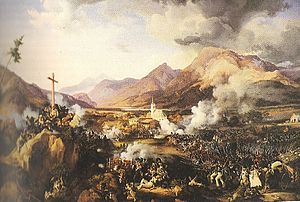Battle of Wörgl facts for kids
Quick facts for kids Battle of Wörgl |
|||||||
|---|---|---|---|---|---|---|---|
| Part of the War of the Fifth Coalition | |||||||
 Battle of Wörgl by Peter von Hess, 1832 |
|||||||
|
|||||||
| Belligerents | |||||||
| Commanders and leaders | |||||||
| Strength | |||||||
| 5,000-8,000 17 guns |
9,000-9,450 18 guns |
||||||
| Casualties and losses | |||||||
| 600-3,000 9 guns-11 guns |
191 | ||||||
The Battle of Wörgl was a major fight during the War of the Fifth Coalition. It took place on May 13, 1809, in the town of Wörgl, which is in modern-day Austria. In this battle, a Bavarian army, led by French Marshal François Joseph Lefebvre, strongly defeated an Austrian group. This Austrian group was commanded by General Johann Gabriel Chasteler de Courcelles. The Bavarians won several smaller fights in nearby towns like Söll and Rattenberg too.
This battle was part of a larger uprising by the people of Tyrol. These brave mountain people, called Tyroleans, were fighting against French and Bavarian rule. They were supported by Austrian soldiers. The victory at Wörgl allowed the Bavarians to take back Innsbruck for a short time. However, the Tyrolean uprising, also known as the Tyrolean Civil Revolt, continued for many months.
Contents
What Was the Battle of Wörgl?
The Battle of Wörgl was a key moment in the 1809 War of the Fifth Coalition. This war was fought between the Austrian Empire and France, led by Napoleon I of France, and its allies. The battle happened because the people of Tyrol had rebelled against their Bavarian rulers. Bavaria was an ally of France at the time.
Why Did the Tyroleans Revolt?
The region of Tyrol had been part of Austria. But after Austria lost a war in 1805, Tyrol was given to Bavaria. The new Bavarian rulers made many changes that the Tyroleans did not like. They took away old freedoms and traditions. They also made young men join the army and ordered vaccinations against smallpox.
These changes made the Tyroleans very angry. Austria saw this and encouraged the people to rebel. When Austria went to war with France and Bavaria in April 1809, the Tyroleans rose up. They quickly formed groups of fighters and drove out most of the Bavarian and French soldiers. This revolt was important because it cut off communication between French armies in Italy and Bavaria.
To help the rebels, Austria sent a group of regular soldiers led by General Chasteler. Before Chasteler arrived, the Tyroleans had a big success in Innsbruck. A Tyrolean leader named Martin Teimer surrounded the Bavarian soldiers there. On May 13, 1809, about 3,860 Bavarian soldiers surrendered. The Tyroleans also captured 2,050 French soldiers.
Meanwhile, Napoleon's main armies were winning battles against the Austrians elsewhere. Napoleon ordered Marshal Lefebvre to take Salzburg, which he did quickly.
Bavarian forces tried to attack Austrian positions in other areas. For example, they tried to take the Lueg Pass but were stopped by a small group of Austrian defenders. Another Bavarian group was defeated by Tyrolean rebels. Napoleon then told Marshal Lefebvre to go help the Kufstein Fortress, which was under attack by Tyrolean and Austrian forces.
On May 11, Bavarian soldiers led by General Deroy reached Kufstein and helped the 576 Bavarian soldiers inside. These soldiers had been surrounded for a month. On the same day, another Bavarian group fought 600 Tyroleans at Lofer. The Bavarians won, but both sides had casualties. The next day, Bavarians fought more Tyroleans at Waidring, pushing them back.
How the Battle Unfolded
The Battle of Wörgl took place southwest of Kufstein. The Bavarian forces, led by General Karl Philipp von Wrede, approached the village of Söll from the east. General Deroy's Bavarian division was also nearby.
Key Leaders and Forces
General Chasteler tried to stop the Bavarians. He had about 5,000 soldiers, most of them regular Austrian troops. They also had 17 cannons. This group included some soldiers from another Austrian division. On the Bavarian side, General Wrede had about 7,500 soldiers and 18 cannons. General Deroy's troops were also close by.
The Fight at Wörgl
The battle was a big defeat for the Austrians. Chasteler's soldiers were badly beaten and had to retreat southwest along the Inn valley. More fighting happened during their retreat at Rattenberg.
About 3,000 Austrian soldiers were killed, wounded, or captured. The Bavarians also captured nine cannons, 27 ammunition wagons, and three flags. This loss greatly weakened Chasteler's army. The Bavarians, on the other hand, had much fewer losses, with only 191 soldiers killed or wounded.
What Happened After the Battle?
After their victory, the Bavarians continued to fight the Tyrolean rebels. On May 14 and 15, General Wrede's soldiers fought 3,000 Tyrolean fighters led by Josef Speckbacher. The Bavarians won these fights, but the rebels still caused them some losses.
Marshal Lefebvre entered Innsbruck by May 20. He thought the rebellion would end soon. However, the Tyrolean revolt was far from over. Even after the main Austrian armies lost a big battle at Wagram in July, the Tyroleans kept fighting.
General Chasteler, following orders, pulled his remaining soldiers out of Tyrol. He tried to join other Austrian armies. He even attacked an Italian division at Klagenfurt but was pushed back. He eventually tried to help stop a siege in Hungary but was not successful.
The Tyrolean revolt grew strong again after Napoleon's defeat at the Battle of Aspern-Essling. The rebels won many battles in June and July. The Bavarians took Innsbruck again, but the Tyroleans defeated them in the third Battle of Bergisel on August 13. This forced the Bavarians out of the mountains once more.
Finally, a new French general, Jean-Baptiste Drouet, Comte d'Erlon, took over from Lefebvre. He won a clear victory against the rebels in the fourth Battle of Bergisel on November 1. This battle largely ended the main part of the rebellion. The fighting slowly stopped by February 1810.




